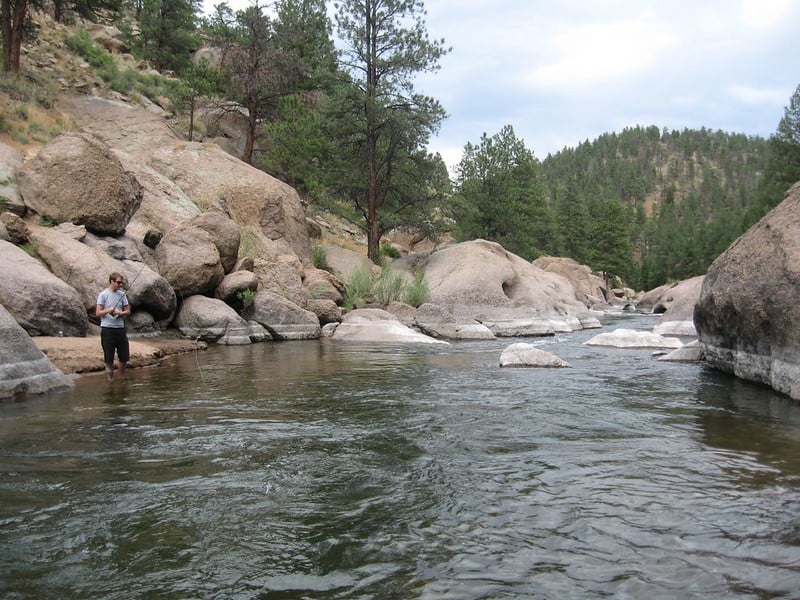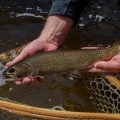What’s At Stake in Cheesman Canyon

Photo: denverkid/Flickr
Earlier this month, massive rainstorms caused flooding that triggered mudslides throughout the Cheesman Canyon section of the South Platte River in Colorado. This section is widely-regarded as one of the premier fly fishing rivers in the country, and it’s where famed South Platte guide Pat Dorsey has worked for decades.
Dorsey is an acclaimed guide, but he’s also an excellent writer and teacher. His photos of fly boxes with microscopic midge patterns are always a favorite on Instagram. His books—like Fly Fishing Tailwaters and Tying and Fishing Tailwater Flies—are staples for many anglers.
Given that so much of his life revolves around the South Platte and Cheesman Canyon, I wanted to hear from Dorsey himself just what’s at stake with the recent natural disasters that have severely impacted the river.
View this post on Instagram
In short, massive rains caused enormous mudslides and floods, which carried huge debris flows comprised of decomposed granite. According to Dorsey’s Instagram posts, the decomposed granite has likely settled on the streambed and covered up much of the insect life.
“I guide the canyon almost exclusively,” Dorsey said. I do the majority of my trips in Cheesman. This is just a blow for me. I don’t know what I’m gonna do. It’s way worse than people think.”
The mudslides triggered by the torrential rains dumped enormous amounts of decomposed granite into the river. In some areas, the mudslides have completely filled in famous holes along the river.
“The meat hole filled in in two days, a hole that is eight, nine, ten feet deep,” Dorsey said. “Completely filled in with granite, just in two days.”
That the river has filled with decomposed granite, in particular, is worrisome to Dorsey, because of the potential impact that substance can have on aquatic insect life.
“I’m not a geologist, so I’m not sure about the granite, but any time there is a sudden, drastic change to habitat, the effects can be immediate and sometimes lasting,” Matt McKell, aquatic biologist with the Utah Division of Wildlife Resources (DWR) said. “I’m certain that locally the insects will show negative impacts; however, they are resilient, and once the impacted areas return to a suitable condition, they’ll be able to inhabit those areas again. The great thing about aquatic bugs is that they also live upstream and will eventually fill in vacant habitats by simply drifting downstream, assuming the vacant areas are suitable.”
That’s the key here—whether the areas suddenly filled with decomposed granite can become suitable for aquatic insect life again, and how soon that might happen.
“Decomposed granite is like a meat grinder, it just constantly moves,” Dorsey said. “You can literally sit at Johnston’s Camp and watch those little pieces of granite literally roll down the substrate. It just chokes everything out. Six, eight, ten feet of granite have filled in those holes, the bug life has to be toast. I don’t see any way, I’m not an aquatic entomologist, but common sense tells me bug life is gone.”
McKell gives a bit more hope than what Dorsey expresses. McKell says that a flush of the river could move the granite out of the holes and help restore that habitat more quickly for aquatic insects, but again, that will take time. And there’s currently no way for a flush to happen. Dorsey has a great relationship with Denver Water, which manages flows through Cheesman Canyon. According to him, all reservoirs are currently at capacity, so there’s no room for a flush to occur. The earliest it could happen would be next spring.
What Dorsey really wanted to drive home, however, was that this isn’t just another “natural” event. This is a devastating moment in the history of Cheesman Canyon.
“People don’t realize the big picture,” Dorsey said. “Most of the river is covered under several inches to ten feet of granite. The bug life is gonna take a huge hit. Of course, the fish are gonna get big heads, skinny bodies. I’ve seen this happen before after the Heyman Fire, we had a flash flood about five years ago. The flash flood wasn’t even close to the damage that was done this go around.”
“That flash flood seemed to work itself out in time. But this one has done some damage that I don’t think can be undone. For instance, the Rainbow Pool and Peanut Run are covered completely and it just choked off that whole right channel, that whole run. It was one of the best holes in the canyon, and I just don’t see that returning to what it was.
“The PMD hatches we were seeing the last month was the best I’ve ever seen guiding that river. The river was just so healthy and so amazing. And now it’s all gone.”
That certainly paints a bleak picture, which is likely warranted with just how devastating these mudslides were. Time will be the ultimate arbiter in this case, but there are a few things Dorsey has planned in the short term.
“I’m just trying to get some manpower so we can get the Gill Trail safe again,” Dorsey said. “Try to be active in some of the repair. Help get some people involved in that project. A lot of it is that we’re at the whim of Mother Nature right now.”
Winchester Dam Repairs Impact Steelhead Run
What Youth Climate Trial Means for Fly Fishing











